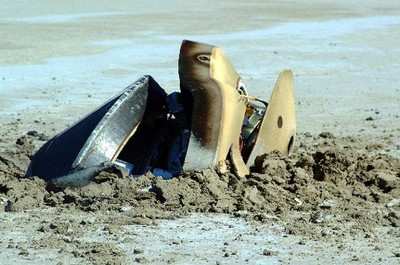Sun, Sep 19, 2004
But It's Looking Good...
Genesis team scientists and engineers continue their work on the
mission's sample return canister in a specially constructed clean
room at the US Army Proving Ground in Dugway (UT). As more of the
capsule's contents are revealed, the team's level of enthusiasm for
the amount of science obtainable continues to rise.

Right now, the science canister that holds the majority of the
mission's scientific samples is lying upside down - on its lid.
Scientists are very methodically working their way "up" from the
bottom portion of the canister by trimming away small portions of
the canister's wall. The team continues to extract, from the
interior of the science canister, small but potentially analyzable
fragments of collector array material. One-half of a sapphire wafer
was collected Tuesday - the biggest piece of collector array to
date.
The mission's main priority is to measure oxygen isotopes to
determine which of several theories is correct regarding the role
of oxygen in the formation of the solar system. Scientists hope to
determine this with isotopes collected in the four target segments
of the solar wind concentrator carried by the Genesis spacecraft.
The condition of these segments will be better known over the next
few days, after the canister's solar wind concentrator is
extricated. At this time, it is believed that three of these
segments are relatively intact and that the fourth may have
sustained one or more fractures.

There are no concrete plans regarding the shipping date of the
Genesis capsule or its contents from Dugway to the Johnson Space
Center in Houston. The team continues its meticulous work and
believes that a significant repository of solar wind materials may
have survived that will keep the science community busy for some
time.
The Genesis sample return capsule landed well within the
projected ellipse path in the Utah Test and Training Range on Sept.
8, but its parachutes did not open. It impacted the ground at
nearly 320 kilometers per hour (nearly 200 miles per hour).
More News
Light Gun A handheld directional light signaling device which emits a brilliant narrow beam of white, green, or red light as selected by the tower controller. The color and type of>[...]
"The journey to this achievement started nearly a decade ago when a freshly commissioned Gentry, driven by a fascination with new technologies and a desire to contribute significan>[...]
Aero Linx: JAARS, Inc. For decades now, we’ve landed planes on narrow rivers and towering mountains. We’ve outfitted boats and vehicles to reach villages that rarely se>[...]
"Our driven and innovative team of military and civilian Airmen delivers combat power daily, ensuring our nation is ready today and tomorrow." Source: General Duke Richardson, AFMC>[...]
Aircraft Conflict Predicted conflict, within EDST of two aircraft, or between aircraft and airspace. A Red alert is used for conflicts when the predicted minimum separation is 5 na>[...]
 ANN's Daily Aero-Term (04.20.24): Light Gun
ANN's Daily Aero-Term (04.20.24): Light Gun Aero-News: Quote of the Day (04.20.24)
Aero-News: Quote of the Day (04.20.24) ANN's Daily Aero-Linx (04.21.24)
ANN's Daily Aero-Linx (04.21.24) Aero-News: Quote of the Day (04.21.24)
Aero-News: Quote of the Day (04.21.24) ANN's Daily Aero-Term (04.21.24): Aircraft Conflict
ANN's Daily Aero-Term (04.21.24): Aircraft Conflict




